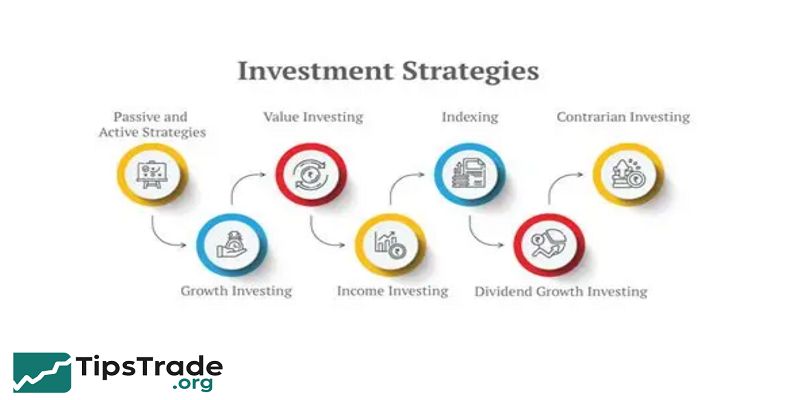Stock investment strategies are essential for guiding investors toward achieving their financial goals while managing risks in the market. These strategies provide systematic approaches to selecting, buying, and selling stocks based on various criteria and market conditions. Visit tipstrade.org and check out the article below for further information
Why You Need a Stock Investment Strategy

A solid investment strategy provides direction and discipline. According to a Fidelity report (2024), investors who stick to a defined plan outperform spontaneous traders by 12–18% over five years.
Key benefits include:
- Reducing emotional bias: strategies prevent panic selling or greed buying.
- Improving performance consistency: structured rules help capture compounding returns.
- Managing risk: diversification and allocation rules balance exposure across sectors.
- Ultimately, a well-planned strategy transforms investing from speculation into a predictable, goal-driven process.
>>See more:
- What is Industry Comparison and How to do it?
- What are Profitability Ratios? Types & Its Significance
- Key Stock Valuation Ratios and When to Use Which One
- How to Read Financial Statements Like a Pro in Stock Investment
Main Types of Stock Investment Strategies

Value Investing
- Value investing targets undervalued companies trading below intrinsic worth.
- Popularized by Benjamin Graham and Warren Buffett, it emphasizes patience and deep analysis.
- Investors evaluate metrics such as P/E ratio, price-to-book value, and free cash flow to find bargains.
- Example: During 2023’s volatile market, Morningstar data showed value stocks outperformed growth stocks by 7%. Best for: long-term investors who can wait for market revaluation.
Growth Investing
- Growth investors seek companies with high revenue and earnings potential, even if valuations seem expensive.
- Think of tech giants like Apple, Amazon, or Nvidia.
- Such investors prioritize metrics like revenue growth rate, EPS momentum, and R&D investment.
While growth stocks can deliver exceptional returns, they also carry higher volatility — particularly during economic downturns. - Tip: Use a “core-and-satellite” approach — keep stable core holdings while allocating a portion to high-growth opportunities.
Dividend Investing
- Dividend strategies focus on companies that pay consistent dividends.
- These stocks provide regular income and potential long-term appreciation.
- Example: The “Dogs of the Dow” strategy selects the 10 highest-yielding Dow Jones stocks each year.
- Historically, this approach has beaten the index in multiple decades (Investopedia).
- Dividend investors assess payout ratios, dividend growth history, and cash coverage to ensure sustainability.
- Ideal for: retirees or income-focused investors seeking steady returns with moderate risk.
Momentum Investing
- Momentum investing assumes that stocks trending upward tend to keep rising — at least for a while
- This strategy uses technical indicators such as relative strength index (RSI), moving averages, and volume patterns.
- According to a 2024 CNBC report, momentum-based ETFs delivered average annual returns of 11% over the past decade.
- However, it requires discipline and quick reactions to market signals. Momentum traders often set strict stop-losses to manage downside risk.
Quantitative & Formula Investing
- Quantitative investors rely on mathematical models to select and rebalance portfolios.
- A famous example is Joel Greenblatt’s Magic Formula, which ranks stocks based on earnings yield and return on capital.
- This method reduces emotional bias and provides data-driven objectivity.
- Pro Tip: Back-test your strategy over 10–15 years of historical data before committing real capital.
Hybrid or Blended Strategies
- Many investors combine multiple approaches — for instance, holding dividend stocks for income while using growth investing for capital appreciation.
- Blended strategies enhance flexibility and allow investors to adapt to market cycles.
- Example: A portfolio mix of 40% value, 40% growth, and 20% dividend stocks can smooth returns and limit drawdowns.
How to Build and Implement a Stock Investment Strategy

Conduct Research and Analysis
Begin with macro and micro analysis:
- Study economic trends, industry outlooks, and company financials.
- Use tools like Yahoo Finance, Morningstar, or TradingView for data and screening.
- Example: Before buying a bank stock, analyze interest rate forecasts and loan growth figures.
Asset Allocation and Risk Management
- Determine your risk tolerance, time horizon, and goals.
- Diversify across industries and regions to reduce volatility.
- Rule of thumb: The longer your time horizon, the higher the stock allocation can be.
- Add bonds or ETFs to stabilize the portfolio during market turbulence.
Holding Period and Investment Discipline
- Successful investors hold quality assets through market fluctuations.
- Research by Vanguard shows that frequent trading reduces average returns by 1–2% per year.
- Stay consistent with your plan, rebalance periodically, and avoid timing the market.
Evaluate and Adjust Over Time
Markets evolve — your strategy should too.
Review performance at least twice a year:
- Rebalance if allocations drift > 5%.
- Replace underperforming assets if fundamentals change.
- Adjust for life events or new financial goals.
Example: Shift toward dividend stocks as you approach retirement
Current Trends and Considerations

Rise of AI and Data-Driven Investing
- Artificial intelligence now powers quantitative models and robo-advisors that analyze millions of data points daily.
- According to Deloitte (2025), AI-assisted portfolios achieve up to 20% better risk-adjusted returns.
ESG and Sustainable Investing
- Environmental, Social, and Governance (ESG) factors influence stock selection for ethical investors.
- BlackRock reports that funds with strong ESG ratings outperformed non-ESG funds by 1.5% in 2024.
- Sustainable investing aligns profits with purpose.
Global Diversification
- Expanding beyond domestic markets helps reduce exposure to local downturns.
- Emerging markets in Asia and Latin America offer higher growth potential but require thorough research and hedging for currency risk.
Conclusion
In conclusion, stock investment strategies offer structured methods for navigating the complexities of the market and enhancing potential returns. A well-chosen strategy can help investors maintain discipline, adapt to changing conditions, and improve long-term financial success.
See more:

